|
-
Beginners Section -
It is important that new
and prospective members should have the correct gear before embarking
on their first hillwalk. Please look at the gear listed below for
an idea of what is required.
For information on what grade of walk new members should start with and
for the general rules of the club, then please visit our Club info & Rules page.
|

|
Hillwalking Gear : - It may sound obvious
but many people new to hillwalking do not appreciate how difficult it
can be walking on Irish mountains. At the base of the mountain, it may
seem mild and calm while at the summit, the temperature can be 5 to 10
degrees cooler with a howling wind. As an island out in the Atlantic,
Ireland gets more than it's fair share of rain and weather conditions
on the hills can change rapidly. More often than not, there are no
tracks and the ground can be wet and boggy.
It pays to have
good gear, especially the correct type of boots and jacket.
|
|
Boots - For Irish conditions, you need
boots that can....
- Handle the
wet
boggy conditions and keep your feet dry
- Give a good
grip on
soft slippery surfaces
- Provide ankle
support
Good hillwalking
stores sell popular brands like Meindl. You should expect to pay in
excess of €100 for a good pair. You really need to go into a good
hillwalking store and see what type of boot suits your feet rather than
buying a pair over the Internet.
|

|
|

|
Jacket - There are many different types.
Some are light and suitable only for mild conditions while others are
suitable for the harshest of winter conditions. A good jacket should...
- Be made from
a
material like Gortex and be breathable. It should let moisture from
sweat pass through yet keep out the rain.
- Have plenty
of
pockets for gloves, scarves, etc.
- Have a storm
flap
at the front to prevent rain getting through the zip
- Provide
protection
from the wind.
Again, it's
probably best to buy them in a good local hillwalking store
rather than over the Internet.
|
|
Trousers - Light trousers or tracksuit
bottoms can be worn. The idea is that if they get wet, they should be
able to dry out quickly. Denim jeans should NEVER be worn. When they
get damp, whether it is due to rain or sweat, they will cling onto your
legs impeding movement and conducting heat away from your body. Some of
the better products are made from a stretchable material which dries
out very quickly. In the summer time, shorts are ideal. Because your
legs are doing most of the work, they tend to stay warm regardless of
conditions.
|
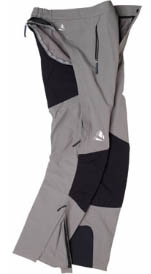
|
|
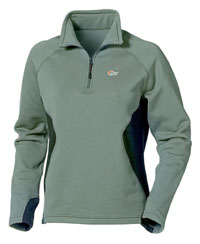
|
Vests & Tops - Ususally the best type
of undergarment to wear is a thermal vest. Cotton T-shirts should be
avoided. The problem with cotton is that it tends to get damp with
sweat and does not dry out easily. The following is what typically
happens to someone who wears a cotton t-shirt :- They walk and start to
sweat.......the cotton T-shirt gets damp but because they are walking,
the T-shirt is still warm......they stop for lunch......they stop
producing heat.....the damp T-shirt gets cold.....now the damp cold
T-shirt conducts heat away from the walker making them feel cold.
Thermal vests on
the other hand are made from man-made materials and they allow a
process called wicking to occur. The material takes the sweat away from
the skin and transfers it to the outside of the garment where it
evaporates easily. Because the thermal vest does not retain as much
moisture, it does not get cold when you stop walking. Typical good
makes are Helly Hansen, Berghaus, Lowe Alpine, etc.
The next layer
above the thermal vest should be a good fleece. It pays to get a good
brand that is a snug fit rather than the cheaper baggy variety which
allow draughts of cold air to get in.
More often than
not, that's all you need to wear on top...a thermal vest, a good fleece
and then the jacket.
|
|
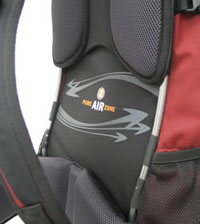
|
Rucksacks - Most beginners think a
rucksack is a rucksack, somewhere where you stick your lunch and flask
and that's it. As with all things in hillwalking, you get what you pay
for. The problem with a typical cheap rucksack (~€20) is that it may
not have padding and will probably be flat. These type can rest in the
small of the back creating a damp spot that goes cold once you stop.
The better quality rucksacks will have an internal frame which leave a
gap between the bag and the walkers back. They often have pull-out rain
covers as well to stop rain getting into the bag. What type you get is
really a personal choice.
|
|
Walking Sticks - These are a matter of
personal preference. Some people swear by them, some don't. They can
take a lot of the pressure off the knees and legs, especially when
walking downhill. It is probably best to borrow a pair or buy a cheap
pair before you commit to buying a good set.
|
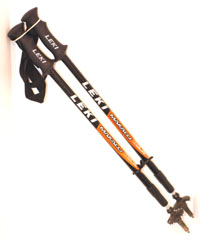
|
|
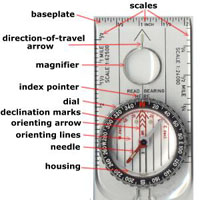
|
Miscellaneous items : -
Compass and
maps........not required by beginners as the walk leader is doing the
navigating. It might be useful at a later stage if you want to learn
the basics.
Flask.......it goes
without saying that a hot drink on a cold day helps a lot. You can buy
more robust versions of a small flask in good hillwalking stores.
Emergency
bag.......large orange emergency bags can be purchased for a small fee.
The idea is that they can be used to keep dry in the event of a serious
accident. They can also double up as a seat when you are looking for a
dry spot on wet ground.
Fold away
mat.......you unfold it and sit on it. Only becomes obvious you need
something like this when you are trying to find a dry spot to sit down.
Gloves......because your hands are usually doing very little work when
you are walking, they are the first part of the body to get cold when
the body is trying to conserve heat. It pays to buy 2 types...a light
pair just to keep the hands warm when there is a slight chill and a
heavy pair for winter conditions.
|
|




















